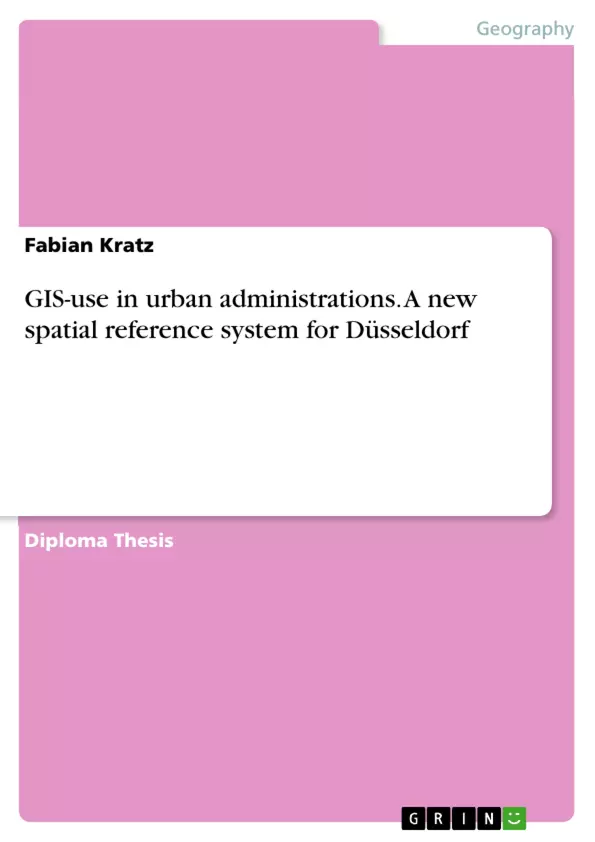This thesis deals with the of problems of GIS-use in urban administrations. It describes the use of GIS and spatial reference systems in urban administrations. Apart from the GIS in Düsseldorf, the use of GIS in Stuttgart, Wuppertal, the Lower-Rhine Region, and Vienna are characterized.
The need for spatial data for administrative performances on the part of the urban administrations in Germany constantly increases. Therefore, it is not anymore about the question: GIS, yes or no? Using GIS in urban administrations is self-evident nowadays, almost every commune uses GIS.
Today, a huge amount of geo-data is available in many different departments of urban administrations. Concerning the programs used to maintain the data and work with it, the different datasets, their underlying data model, and the seldom available meta-data it is clear to see, that this field of applications is very diverse. This diversity is not only characterized by a multiplicity of programs, datasets, and data models, but also by differing geometrical quality. These differences in the data quality are either due to differing data coverage procedures, or due to a loss of information during converting data.
Several urban administrations tried to rectify the problems that derived from this diversity. In Vienna for example, a completely new system was established that integrates all other GIS used before.
Other cities started to renew their GIS and spatial reference systems for the same reason. Düsseldorf however, is a city that till now did not replace its current system.
Inhaltsverzeichnis (Table of Contents)
- 1. Introduction
- 1.1 Structure
- 1.2 Objective
- 1.3 Limitations
- 2. Course of Investigation
- 2.1 Definitions
- 2.2 Methodology
- 3. Spatial Reference Systems in Urban Administration
- 3.1 MERKIS Recommendation
- 3.2 GIS in Düsseldorf
- 3.2.1 MapInfo
- 3.2.2 Structure of Düsseldorf's GIS
- 3.3 GIS in other Municipalities
- 3.3.1 Stuttgart
- 3.3.2 Wuppertal
- 3.3.3 KRZN - Communal Computing Centre Lower-Rhine Region
- 3.3.4 Vienna
- 4. Requirements in Düsseldorf
- 4.1 Tasks to carry out in the selected Department
- 4.2 Requirements concerning GIS
- 4.3 Problems in Departments
- 5. Possible System Improvements
- 5.1 Exemplary System Components
- 5.1.1 Shared Network-Graphs
- 5.1.2 Geo-Data Warehouse
- 5.1.3 Development and Implementation of individual Functionalities
- 5.2 Obstacles concerning the Realisation Process
- 6. Conclusions and Recommendations
Zielsetzung und Themenschwerpunkte (Objectives and Key Themes)
This work explores the challenges of utilizing Geographic Information Systems (GIS) within urban administrations in Germany. The main objective is to analyze the current state of GIS implementation in Düsseldorf, identify shortcomings, and propose potential solutions for improvement. The author aims to achieve this by comparing Düsseldorf's system with successful GIS implementations in other German and Austrian cities, drawing on interviews with personnel involved in GIS management within the Düsseldorf administration.- The growing importance of spatial data in urban administration
- The diverse range of GIS applications and challenges related to data management
- The need for a unified and efficient spatial reference system in urban administration
- Exploring successful GIS implementations in other municipalities
- Proposing improvements for Düsseldorf's GIS based on best practices and analysis
Zusammenfassung der Kapitel (Chapter Summaries)
The work begins by introducing the increasing demand for spatial data in urban administration in Germany, emphasizing the widespread adoption of GIS across municipalities. The author then outlines the structure and objectives of the study, highlighting the limitations posed by the complex and heterogenous nature of Düsseldorf's GIS system.
Chapter 2 provides definitions and details the methodology employed in the research. Chapter 3 delves into the utilization of GIS and spatial reference systems in urban administration, including a comparative analysis of GIS implementation in Düsseldorf, Stuttgart, Wuppertal, the Lower-Rhine Region, and Vienna.
Chapter 4 examines the specific requirements of the Düsseldorf administration regarding GIS and the challenges posed by the current system. Chapter 5 explores potential solutions for improving Düsseldorf's GIS, drawing on examples from the other cities discussed and incorporating insights from the author's interviews with Düsseldorf administration personnel.
Schlüsselwörter (Keywords)
This work focuses on the application of Geographic Information Systems (GIS) within urban administration, specifically examining the challenges of data management, interoperability, and system improvement. Key themes include spatial data management, data quality, GIS implementation, urban administration, and system integration. The study draws upon examples of successful GIS implementations in cities like Stuttgart, Wuppertal, and Vienna, as well as the author's insights from interviews with GIS personnel in Düsseldorf.- Citation du texte
- Fabian Kratz (Auteur), 2010, GIS-use in urban administrations. A new spatial reference system for Düsseldorf, Munich, GRIN Verlag, https://www.grin.com/document/214456



